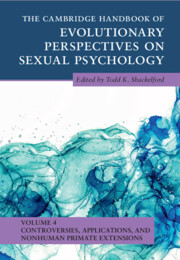Book contents
- The Cambridge Handbook of Evolutionary Perspectives on Sexual Psychology
- The Cambridge Handbook of Evolutionary Perspectives on Sexual Psychology
- Copyright page
- Contents
- Contributors
- Preface
- Part I Controversies and Unresolved Issues
- Part II Applications to Health, Law, and Pornography
- 6 Male Reproductive Health
- 7 Women’s Menstrual Cycles and Ovulation Provide Balanced Estradiol and Progesterone for Fertility and Lifelong Health
- 8 Female Genital Cutting
- 9 Costs of Polygyny
- 10 Male Sexual Disorders
- 11 An Evolutionary Perspective on Female Sexual Concerns and Dysfunctions
- 12 Evolutionary Perspectives on Male Sexual Offending
- 13 Pornography and Male Sexual Psychology
- Part III Nonhuman Primate Sexual Behavior
- Index
- References
12 - Evolutionary Perspectives on Male Sexual Offending
from Part II - Applications to Health, Law, and Pornography
Published online by Cambridge University Press: 30 June 2022
- The Cambridge Handbook of Evolutionary Perspectives on Sexual Psychology
- The Cambridge Handbook of Evolutionary Perspectives on Sexual Psychology
- Copyright page
- Contents
- Contributors
- Preface
- Part I Controversies and Unresolved Issues
- Part II Applications to Health, Law, and Pornography
- 6 Male Reproductive Health
- 7 Women’s Menstrual Cycles and Ovulation Provide Balanced Estradiol and Progesterone for Fertility and Lifelong Health
- 8 Female Genital Cutting
- 9 Costs of Polygyny
- 10 Male Sexual Disorders
- 11 An Evolutionary Perspective on Female Sexual Concerns and Dysfunctions
- 12 Evolutionary Perspectives on Male Sexual Offending
- 13 Pornography and Male Sexual Psychology
- Part III Nonhuman Primate Sexual Behavior
- Index
- References
Summary
Evolutionary psychology has been suggested to be a promising method to explain the incidence of sexual offending. We identify and discuss three major theoretical approaches to the explanation of sexual offending (specifically male rape). First, we discuss selectionist approaches, which position rape as a distinct outcome of evolutionary processes relating to mating and reproduction, either as a direct adaptation or an evolutionarily related by-product. Second, we discuss evolutionary-developmental approaches which discuss rape in relation to similar evolutionary functions (e.g. mating and reproduction) but with an emphasis on how rape develops over the lifespan. Third, we discuss Malamuth’s confluence model, which considers rape to be an outcome of a range of psychological and situational variables which fall on two broad explanatory pathways (hostile masculinity and sexual promiscuity). We suggest that while these perspectives all have clear merit, they generally lack specificity in relation to causal mechanisms and neglect proximate-level (immediate) explanations. We suggest a possible alternative approach to be one which applies evolutionary theory to the underlying psychological mechanisms which constitute rape directly, which we illustrate through the example of the integration of evolutionary accounts of emotion to the explanation of problematic sexual interests.
- Type
- Chapter
- Information
- Publisher: Cambridge University PressPrint publication year: 2022



